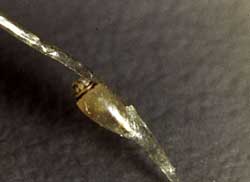LiceMD (tm) and similar products for head lice
A nit-combing aid
Just in time for the start of school we have a head lice treatment. LiceMD (tm) is a liquid gel of a silicone lubricant called dimethicone. Like similar products, LiceMD (tm) detangles and lubricates hair making nit combing with fine-tooth lice combs easier and more effective. Nit (louse egg) removal is the single most important part of any lice control procedure. LiceMD contains no pesticides and is odor free and hypoallergenic.
The manufacturer claims that LiceMD eliminates head lice in 10 minutes but I think this claim is a bit of an exaggeration because it is the comb-out that actually removes nits and even the manufacturer's website states that the comb-out will take "1-2 hours".
Nonetheless, if LiceMD or another product will make nit-combing easier and more effective it is probably worth a try.
Head lice and school kids - background information
As kids return to the classroom this fall head lice will once again be an issue in many grade schools. Head lice are small, wingless insects that bite in order to feed on our blood, much like mosquitoes and bed bugs. The bites are not medically significant but do produce intense itchiness, and, let's face it, extreme revulsion at the thought of something feeding on us or especially our kids! As an extension entomologist (now retired) at Oregon State University I get questions from teachers and parents every year about head lice control.
Interest seems to peak in the fall when kids return to school. Over the years it has become clear that the best way to eliminate a head lice infestation is to go after the nits (lice eggs). The best way to eliminate nits is, however, both tedious and time consuming. This article describes some ways to make nit removal a little quicker and easier.
 |
| louse egg (nit) |
Head lice start out as tiny eggs, or nits, that are attached to hairs (see photo), generally near the scalp and often on the nape of the neck and around the ears. Nits hatch in a few days and the head lice begin biting. All stages feed on blood but it may take several weeks or longer for a louse infestation to get large enough to be noticed. Head lice are very contagious and can spread from kid to kid through close contact or sharing of hats, brushes, and such. Parents and teachers know that a single infested student can spread lice throughout a classroom.
Because of this potential to pass lice from child to child many schools have adopted so-called no-nit policies that are meant to exclude infested children from school until they are treated. While we do not advocate no-nit policies (here's why), it turns out that nit removal is the single most effective way to stop a head louse infestation in its tracks.
How does LiceMD, and similar products, work?
So what's the best way to eliminate nits and stop an infestation? Simple combing, with the proper type of comb, is the best way to remove and kill nits. Combing with a fine-tooth metal lice comb scrapes away or crushes nits between the teeth of the comb.
Regular combs don't work. You must use a fine-toothed metal lice comb to be effective. Combing works better than medicated shampoos or conditioners which work well on immature and adult stages of these blood suckers but not very well on eggs. The problem with fine-toothed metal combs is they are murder to pull through hair. Even short hair is tough to comb with these nasty torture devices and long hair is a nightmare. Most people give up and hope that the medicated shampoos and conditioners do the job. Sometimes they do work but many times shampoos and conditioners alone fail, and the failure is sometimes falsely blamed on "pesticide resistance". The real reason shampoos and conditioners fail (besides the fairly rare occurrence of actual pesticide resistance) is because nits hatch after the effects of the shampoos and conditioners wear off and these new lice start the infestation all over again.
So how can you make nit combing easier so both you and your child will tolerate the whole procedure? This is where nit-combing aids come in to play. Nit-combing aids are lotions or gels that make hair slippery so that the fine-tooth nit comb glides over individual hair strands easier with less pulling, tangling, and crying. There are two products to consider trying and both work in a similar way. LiceMD (tm) is applied to dry hair whereas RID Lice & Egg Comb-Out Gel (tm) is applied to damp hair after shampooing.
The active ingredient in LiceMD is dimethicone, a type of silicone oil which makes hair very slippery and easier to comb. The RID product is a more conventional hair conditioner. Either product is somewhat messy so be patient and work slowly and carefully. The silicone oil in LiceMD won't dry out while combing. Both products should be washed out of the hair when done and both should be combined with a lice shampoo or conditioner to kill active lice stages. Treating of bedding, clothing and household furnishings with insecticide, however, is not necessary.
__________



Comments